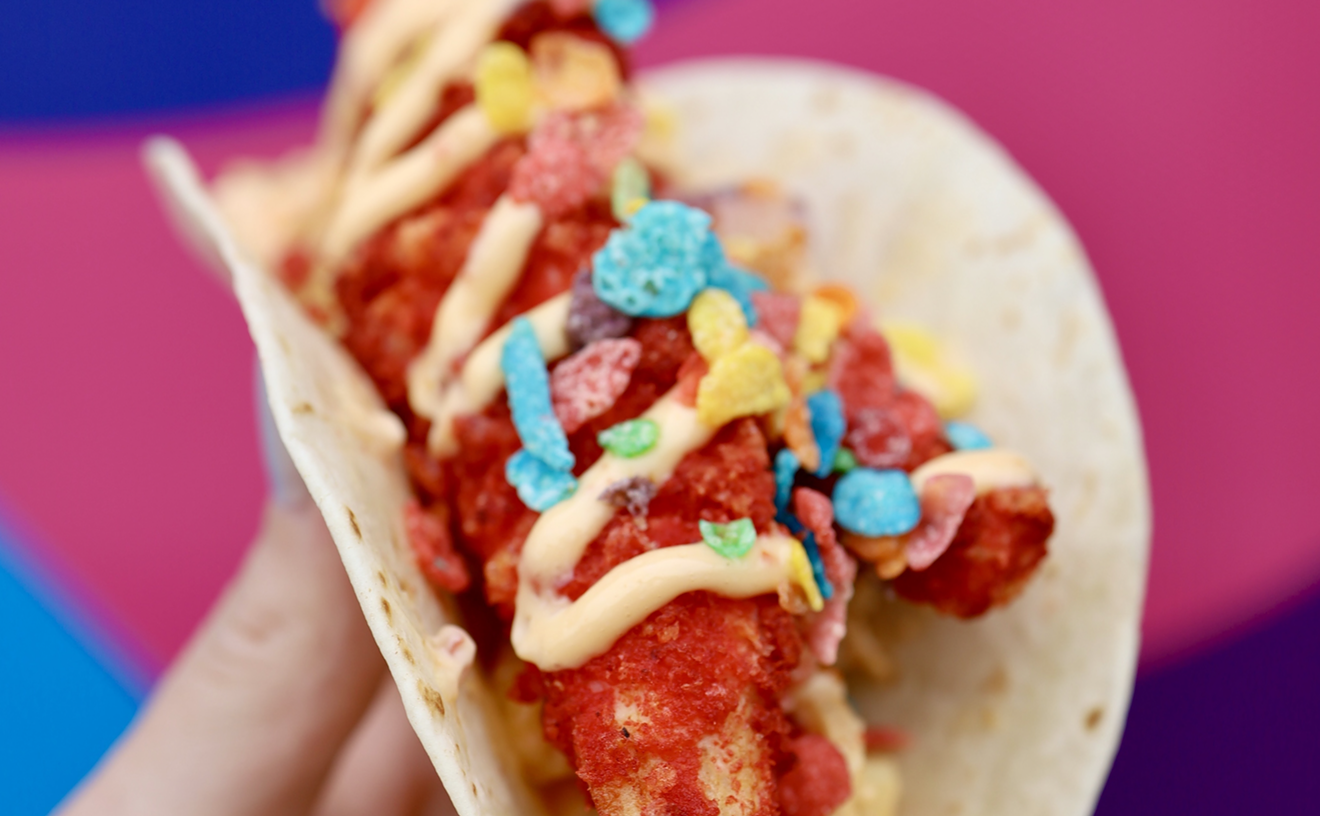In this national and international melting pot that is Hong Kong food, the Guangdong (Cantonese) influence predominates. But that doesn't much help narrow the definition of Hong Kong-style cuisine. According to a famous nineteenth-century Cantonese proverb: "Anything that walks, swims, crawls, or flies with its back to Heaven is edible." In the Twentieth Century, this was updated to: "We eat everything on the ground with four legs except tables and chairs. We eat everything in the sky except airplanes." Hong Kong's waterfront location means that everything in the sea not wearing a swimsuit is also fair game. The basic rule: If it isn't chattering into a cell phone, throw it in the wok.
Among Hong Kong's most famed fare is a soup made from antlers, fish glue, and tree bark. There are also various wines made from snakes, deer penises, or still-suckling baby mice. A special wedding dessert features snow frog sperm glands.
For better or worse, diners will not find any of the above dishes at the new, much-anticipated Miss Yip Chinese Café. Proprietor Jenny Yip, who also co-owns the Townhouse Hotel's sushi spot Bond Street, was in much evidence on all four of my visits, supervising both the kitchen and the front of the house.
Located in the space formerly occupied by the late, unlamented Bambú, Miss Yip's café, which features a lounge and mini-market, bears no resemblance to Bambú's A-list pretensions and Eurotrash clientele. Instead you find a pleasantly eclectic mix of people -- many nationalities, all ages, and attire ranging from suits to sneakers. The food is similar, an affordable combination of familiar Chinese classics (albeit generally more skillfully prepared than at most Miami Asian joints) and unusual items -- but not too unusual. "Rice wine, not mice wine" is the policy here.
At lunchtime, from noon to 3:00 p.m., two dozen bargain ($8.88) combination plates are available, but the excitement centers on Miss Yip's dim sum. Translating as "touch the heart" (and alternatively called yum cha, "drink tea"), dim sum are the world's first "small plates," originating as Cantonese teahouse snacks sometime in the Tenth Century. For me a plate containing a few dumplings or roast duck pieces, or perhaps a petite serving of baby bok choy is an afternoon pick-me-up. Three or four plates, with a pot of Miss Yip's delicate jasmine tea, make an ample midday meal. Adding fun to the food, items are served, as at classic dim sum eateries, from rolling carts so diners can point to whatever appeals. And unlike many classic places, Miss Y's servers speak enough English to explain items -- though not always accurately. The squashlike filling inside some sesame lotus seed balls was not bean curd, as I was assured twice, but sweet bean paste.
The dim sum selection at Miss Yip ($3.50 to $5.50) is relatively limited, and the dumplings were not, frankly, the translucent wonders found in top dim sum parlors in San Francisco, New York City, or Vancouver (or even at Kon Chau or Tropical Chinese here in Miami). But neither were they the leaden, flavorless, and often frozen specimens encountered in most eateries that attempt China's savory pastries.
Steamed har gau and siu mai had fairly thin-skinned wrappers stuffed plumply with, respectively, delectable chopped shrimp and ground pork plus vegetables. Equally mouthwatering were steamed Chinese mushroom dumplings, whose filling had just a touch of heat. Bean curd rolls, made with lean sheets of preserved curd, moved me to take back every nasty thing I ever said about tofu being bland. The filling in the vegetarian spring rolls was indeed bland, but pan-fried vegetable dumplings and three-star vegetable dumplings were beautifully spiced. Golden corn shrimp balls were an interesting idea (the shrimp paste rounds came coated with corn kernels) but unfortunately were too heavy. Everyone, though, is entitled to an occasional miss. Sesame is a Hong Kong flavor favorite, and those misidentified sesame lotus balls proved to be alluring dessert dim sum, regardless of their name. (Speaking of sesame, Miss Yip's mini-market stocks Kadoya brand, one of the best. The market is really just a few shelves of Asian ingredients located along the passageway leading to the lounge. The selection is limited but the quality is superior. Pearl River Bridge soy sauce, for example, is a treat rarely found in even the best gourmet shops.)
The dinner menu offers just four or five dumpling options, but diners will hardly go hungry. Among the appetizers, barbecued ribs were outstanding -- big, meaty, so juicy they practically spurted. Soups included an assertively chili-spiked hot-and-sour that was thickened far too much with cornstarch but packed with bamboo, carrot, tofu, and mushroom shreds (no pork, which may have been accidental but a boon to vegetarians). The best soup, strangely, was won ton. In most Chinese restaurants this stuff might as well come with a sign reading, "For wimps only." But Miss Yip's homemade version, featuring two absolutely ethereal won tons filled with perfectly cooked shrimp (rather than pulverized pork), floating in a subtly piquant broth, demonstrated why this delicacy is considered a Hong Kong highlight.
Salt-and-pepper preparations of lightly battered seafood are also popular in Hong Kong, and Miss Yip has two. A starter (actually entrée-size) of squid was unimpressive owing mainly to a complete lack of salt. Additionally the calamari chunks were unappetizingly large and overcooked to the point of toughness, while the coating was, somehow, undercooked -- soggy rather than crisp. The salt-and-pepper shrimp were much better, jumbo prawns sufficiently salted with a generous topping of sautéed red, green, and chili peppers. Personally I'd have preferred the shrimp served shell-on instead of shelled, but the authentic preparation, which the restaurant tried in its first days, was evidently a bit too adventuresome for South Beach.
Expensive but worth every cent was Cantonese wok-baked lobster. Served with its shell and arranged around a mound of stir fry, the lobster meat had been butterflied before being flash-sautéed with vegetables in black bean sauce that clearly was made from scratch -- that is, not just processed gravy; whole preserved beans were in evidence. The petite lobster could only have been better had it been twice as big.
Moo shu pork, a Beijing specialty, was somewhat odd. Absent was its characteristic titular ingredient. "Moo shu" means "cassia flower," whose yellow buds are traditionally imitated in this dish by scrambled eggs. Was the absence of egg flowers an attempt at health consciousness? Possibly, since most of Miss Yip's food is also less oily than at average Chinese eateries. At any rate, the shredded mélange of pork, bamboo shoots, tree-ear fungus, and other vegetables did not lack full flavor. It was served with a bowl of hoisin sauce and four thin Mandarin pancakes for wrapping, as our waiter helpfully explained, "like a Chinese Mexican taco."
The real surprise, though, was an order of moo shu vegetables. Over the course of a long relationship with a semi-vegetarian, I've tried meat-free adaptions of countless Chinese recipes that traditionally contain meat: roast duck chow fun without the duck, dry-sautéed string beans without the ground pork, and many nonmeat moo shus. Invariably the vegetarian versions have lacked flavor. Not this one. Masterful spicing made the vegetable version just as robust as the moo shu pork's, and additional fresh veggies made the crunch factor far superior. It was uncommonly good.
Two other vegetable dishes I tried were also wonderful: vibrant, emerald-green Chinese broccoli in oyster sauce (the real thing, not just regular broccoli or broccoli rabe), and Chinese eggplant in an equally succulent sauce with peppers and onions. A tablemate marveled, "I didn't know they could do something this good to eggplant."
Among the dessert offerings, the coconut pudding did not find favor with dining companions accustomed to flan, whose custardy texture was missing. However, the mango pudding, just as lightly gelatinous but tasting somehow richer because of its more aggressive fruitiness, was a huge crowd-pleaser.
No one needs a fortune cookie to see that a winning combination of casually elegant ambiance and very good Chinese food surely means Miss Yip will be attracting crowds.
Food Writers Wanted
We're looking for freelance writers with at least one year experience describing food and restaurants. Please send clips, résumé, and cover letter to:
Jim Mullin, editor
Miami New Times
P.O. Box 011591
Miami, FL 33101
No phone calls, please










